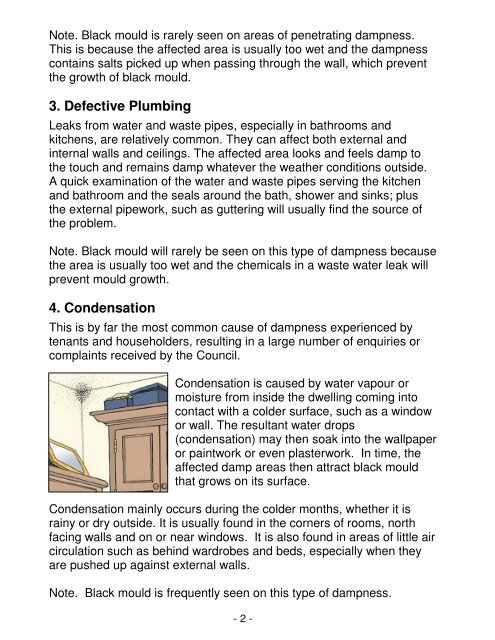Damp-Info-Leaflet
Damp-Info-Leaflet
Damp-Info-Leaflet
Create successful ePaper yourself
Turn your PDF publications into a flip-book with our unique Google optimized e-Paper software.
Note. Black mould is rarely seen on areas of penetrating dampness.<br />
This is because the affected area is usually too wet and the dampness<br />
contains salts picked up when passing through the wall, which prevent<br />
the growth of black mould.<br />
3. Defective Plumbing<br />
Leaks from water and waste pipes, especially in bathrooms and<br />
kitchens, are relatively common. They can affect both external and<br />
internal walls and ceilings. The affected area looks and feels damp to<br />
the touch and remains damp whatever the weather conditions outside.<br />
A quick examination of the water and waste pipes serving the kitchen<br />
and bathroom and the seals around the bath, shower and sinks; plus<br />
the external pipework, such as guttering will usually find the source of<br />
the problem.<br />
Note. Black mould will rarely be seen on this type of dampness because<br />
the area is usually too wet and the chemicals in a waste water leak will<br />
prevent mould growth.<br />
4. Condensation<br />
This is by far the most common cause of dampness experienced by<br />
tenants and householders, resulting in a large number of enquiries or<br />
complaints received by the Council.<br />
Condensation is caused by water vapour or<br />
moisture from inside the dwelling coming into<br />
contact with a colder surface, such as a window<br />
or wall. The resultant water drops<br />
(condensation) may then soak into the wallpaper<br />
or paintwork or even plasterwork. In time, the<br />
affected damp areas then attract black mould<br />
that grows on its surface.<br />
Condensation mainly occurs during the colder months, whether it is<br />
rainy or dry outside. It is usually found in the corners of rooms, north<br />
facing walls and on or near windows. It is also found in areas of little air<br />
circulation such as behind wardrobes and beds, especially when they<br />
are pushed up against external walls.<br />
Note. Black mould is frequently seen on this type of dampness.<br />
- 2 -


